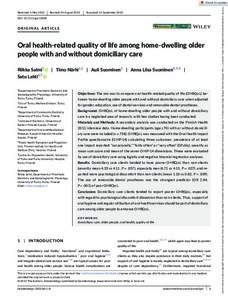Oral health-related quality of life among home-dwelling older people with and without domiciliary care
Lahti Satu; Suominen Anna Liisa; Suominen Auli; Salmi Riikka; Närhi Timo
Oral health-related quality of life among home-dwelling older people with and without domiciliary care
Lahti Satu
Suominen Anna Liisa
Suominen Auli
Salmi Riikka
Närhi Timo
WILEY
Julkaisun pysyvä osoite on:
https://urn.fi/URN:NBN:fi-fe2022112967860
https://urn.fi/URN:NBN:fi-fe2022112967860
Tiivistelmä
Objectives The aim was to compare oral health-related quality of life (OHRQoL) between home-dwelling older people with and without domiciliary care when adjusted for gender, education, use of dental services and removable dental prostheses. Background OHRQoL of home-dwelling older people with and without domiciliary care is a neglected area of research, with few studies having been conducted. Materials and Methods A secondary analysis was conducted on the Finnish Health 2011 interview data. Home-dwelling participants (age >= 70) with or without domiciliary care were included (n = 758). OHRQoL was measured with the Oral Health Impact Profile questionnaire (OHIP-14) calculating three outcomes: prevalence of at least one impact reported: "occasionally," "fairly often" or "very often" (OFoVo), severity as mean sum score and mean of the seven OHIP-14 dimensions. These were evaluated by use of domiciliary care using logistic and negative binomial regression analyses. Results Domiciliary care clients tended to have poorer OHRQoL than non-clients (severity mean 4.33 vs 4.11, P = .057), especially men (6.71 vs 4.15, P = .027), and reported more psychological discomfort than non-clients (mean 1.10 vs 0.82, P = .039). The use of removable dental prostheses was the strongest predictor (OR 2.84, P < .001) of poor OHRQoL. Conclusion Domiciliary care clients tended to report poorer OHRQoL, especially with regard to psychological discomfort dimension than non-clients. Thus, support of oral hygiene and regular utilisation of oral health services should be part of domiciliary care among older people to enhance OHRQoL.
Kokoelmat
- Rinnakkaistallenteet [19207]
